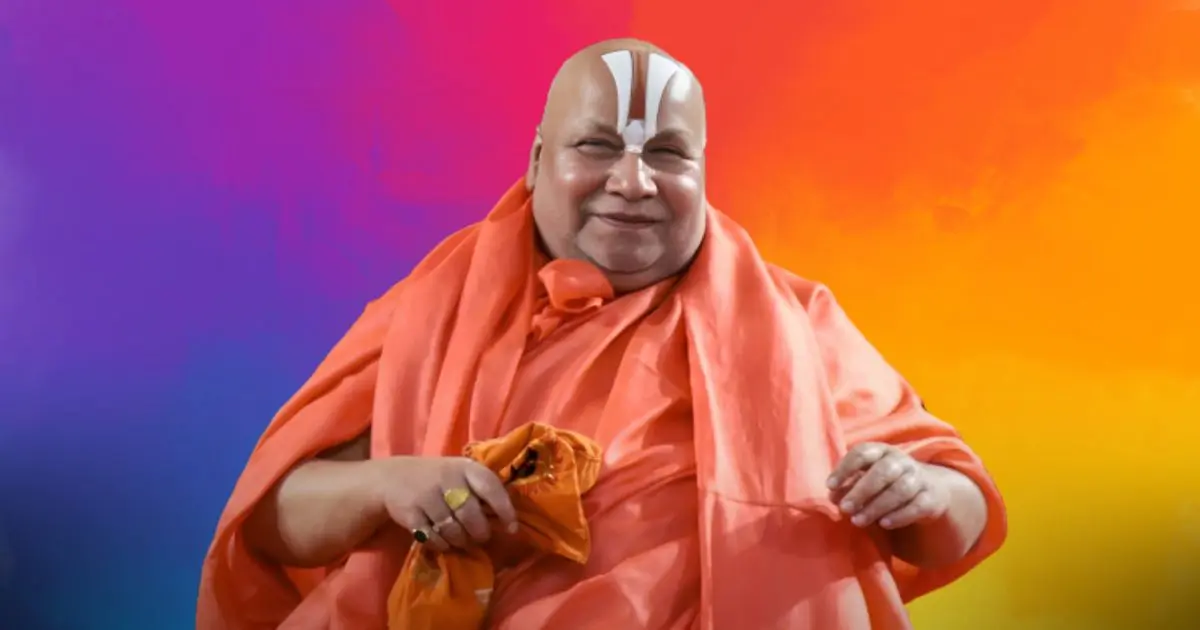Jagadguru Shri Rambhadracharya is a remarkable figure who made a significant impact, especially in the context of the Ram Janmabhoomi case, where his testimony played a crucial role. He silenced the concerns of 20 crore Muslims with his powerful insights. Let’s dive into his extraordinary life.
One of his most significant contributions came during the Ram Janmabhoomi case when the Muslim side raised the question of why Tulsidas did not mention the demolition of the Ram temple by Babar.
This question posed a significant challenge for the Hindu side. However, Rambhadracharya came to the rescue, testifying in the Allahabad High Court and referencing a couplet written by Tulsidas that addressed the destruction of the Ram temple by commander Babar’s Mir Baqi. His testimony was pivotal in addressing this critical question.
Jagadguru Shri Rambhadracharya holds various titles and has made substantial contributions in diverse fields. He is a spiritual leader, teacher, Sanskrit scholar, poet, philosopher, lyricist, singer, litterateur, and storyteller. Notably, on June 24, 1988, he was honored with the title of Jagadguru by the Kashi Vidvat Parishad.
He is the founder of Tulsi Peeth and serves as the lifetime Vice Chancellor of Jagadguru Rambhadracharya Handicapped University. He also plays an inspiring role within the Vishwa Hindu Parishad, further strengthening his influence among the Hindu community.
Page Index
Early Achievements and Influence
- Born on January 14, 1950, in Chitrakoot, India.
- Became blind at the age of 2 months.
- A child prodigy who wrote his first poem at the age of 3.
- Memorized 700 verses of the Srimad Bhagwat Geeta by the age of 5.
- Memorized 10,900 quatrains and verses of Shri Ramcharitmanas in just 60 days at the age of 7.
- Known for his testimony in the Ram Janmabhoomi case that provided evidence from Tulsidas’s writings about the destruction of the Ram temple by Mir Baqi.
Scholarly and Institutional Contributions
- He is proficient in 22 languages despite his blindness.
- Authored over 100 books and contributed 50 research papers.
- He was conferred the title of Jagadguru by the Kashi Vidvat Parishad on June 24, 1988.
- Founder of Tulsi Peeth.
- Lifetime Vice Chancellor of Jagadguru Rambhadracharya Handicapped University.
- Plays an influential role within the Vishwa Hindu Parishad.
Early Life
The saga of Jagadguru Rāmānandāchārya Swāmī Rāmabhadrācārya begins in the sacred land of India, where he incarnated into a pious Sarayupārīṇa Brāhmaṇa family of the Vaśiṣṭha Gotra.
This divine soul took his first breath on the auspicious day of Makara Saṅkrānti, January 14, 1950 (Māgha Kṛṣṇa Ekādaśī, Vikrama Saṃvat 2006) on the auspicious day of Makar Sankranti. He was born to Śacī Devī Miśra and Paṇḍita Rājadeva Miśra in the rustic village of Shandikhurd in the Jaunpur district of Uttar Pradesh, India.
Notably, he received his name “Giridhara,” an ode to Lord Kṛṣṇa, from a cousin of his paternal grandfather, an ardent devotee of Mirābaī. Jagadguru Shri Rambhadracharya, also known as Swami Giridhar in his childhood. His life story is one of exceptional accomplishments, despite facing the challenge of blindness, which occurred when he was only two months old.
From an early age, his intellectual prowess and dedication to knowledge were evident. At the tender age of three, he penned his first poem. By the age of five, he had already memorized an astonishing 700 verses of the entire Srimad Bhagwat Geeta, including chapter and verse numbers.
At seven, in an astounding feat, he memorized 10,900 quatrains and verses of Shri Ramcharitmanas in a mere 60 days. This remarkable child, Giridhar, is now renowned worldwide as Jagadguru Shri Rambhadracharya.
Despite his blindness, Jagadguru Shri Rambhadracharya is a multilingual genius, conversant in 22 languages. He has authored over 100 books and contributed 50 research papers, cementing his reputation as a great scholar.
Loss of Physical Eyesight
Fate, mysterious and profound, intervened in the life of Giridhara at the tender age of two months. The lotus eyes of this infant were touched by Trachoma (a disease caused by infection with the bacterium Chlamydia trachomatis), an affliction of his physical eyes that modern medicine couldn’t remedy due to the limited healthcare resources in his village.
In a divine twist of destiny, Lord Śrī Rāma himself seemed to have chosen this path for Giridhara. To shield him from witnessing the horrors of Kaliyuga, the Lord blessed him with divine internal vision, akin to the sight that graced Arjuna and Sañjaya during the Kurukṣetra battlefield.
This divine sight was a gift that would stay with Giridhara for life, allowing him to perceive the world in an entirely unique way.
Early Education
The foundations of Giridhara’s extraordinary education were laid at home under the guidance of his grandfather, Paṇḍita Sūryabalī Miśra. Remarkably, at just five years of age, he had committed the entire Bhagavad Gītā to memory, absorbing approximately 800 verses, complete with chapter and verse numbers.
By the time he reached the age of eight, the young prodigy had already memorized Saint Tulasīdāsa’s monumental work, the Rāmacaritamānasa, a scripture comprising around 10,800 verses.
This incredible feat was accomplished with the loving support and guidance of his grandfather. As he continued his educational journey, Giridhara’s mastery expanded to include the Vedas, the Upaniṣads, the Bhāgavata Purāṇa, substantial works of Sanskrit grammar, and the complete literary legacy of the esteemed poet-saint Tulasīdāsa.
His Upanayana Saṃskāra, symbolizing his initiation into sacred knowledge, was performed on June 24, 1961, during the sacred Nirjala Ekādaśī. On this auspicious day, he received not only the sacred Gāyatrī Mantra but also was initiated (Dīkṣā) into the sacred Rāma mantra by Paṇḍita Īśvaradāsa Mahārāja of Ayodhyā.
Higher Education
Giridhara’s pursuit of knowledge led him to the Ādarśa Gauriśaṅkara Saṃskṛta Mahāvidyālaya in Jaunpur in 1966. There, he embarked on a five-year journey, diving into the intricate nuances of Sanskrit grammar and other academic disciplines.
His exceptional ability to absorb knowledge after a single hearing elevated him to the top of his class for five consecutive years. In 1971, the young and scholarly Giridhara ventured to the Sampūrṇānanda Saṃskṛta Viśvavidyālaya in Vārāṇasī for his advanced studies.
His brilliance shone even brighter in 1973 when he traveled to New Delhi to participate in national-level Sanskrit competitions during the Akhila Bhāratīya Saṃskṛta Adhiveśana. To everyone’s amazement, he clinched five gold medals across various subjects, including Vyākarana, Sāṅkhya, Nyāya, Vedānta, and Antyākṣarī.
So extraordinary was his genius that even Prime Minister Indira Gandhi offered to send him to the USA for treatment to restore his vision, but Giridhara Miśra graciously declined this remarkable offer.
In subsequent years, the accolades kept pouring in. In 1973 and 1976, Giridhara achieved top honors in the Śāstrī (Bachelor) and Ācārya (Master) examinations in Vyākaraṇa from the Sampūrṇānanda Saṃskṛta Viśvavidyālaya, earning coveted gold medals for his academic prowess.
In a remarkable turn of events, he was designated the Ācārya of all subjects taught at the university, underscoring his exceptional scholarship and overall competence. Collaborating with Paṇḍita Rāmaprasāda Tripāṭhī, Giridhara Miśra completed his doctoral Vidyāvāridhi degree (PhD) in 1981 from Sampūrṇānanda Saṃskṛta Viśvavidyālaya.
His doctoral thesis, composed in Sanskrit, was titled “Adhyātmarāmāyaṇe Apāṇinīyaprayogānāṃ Vimarśaḥ,” which extensively deliberated non-Paninian usages in the Adhyātma Rāmāyaṇa. His insatiable hunger for knowledge didn’t end there.
In 1997, he was honored with the post-doctoral Vācaspati degree (DLitt) by the same university, this time for his second Sanskrit dissertation, “Aṣṭādhyāyyāḥ Pratisūtraṃ Śābdabodhasamīkṣaṇam.” In this work, he illuminated the intricate grammar of Aṣṭādhyāyī through lucid verses, showcasing his deep scholarship and academic dedication.
Life After Virakta Diksa
Tulasī Pīṭha
Following the path of celibacy and commitment to a life of devotion, Giridhara Miśra, now known as Rāmabhadrādāsa, took the Vairagī initiation (Virakta Dīkṣā) in the Rāmānanda Sampradāya on the sacred Kārtika full-moon day, November 19, 1983.
This initiation was a pivotal moment in his spiritual journey, marking his unwavering commitment to a life of dedicated service to the divine.
In accordance with the traditions of the Sampradāya, he received the name “Rāmabhadrādāsa,” signifying his servitude to the auspicious Lord Rāma. In 1987, he founded the Tulasī Pīṭha, known as the seat of Tulasī, the sacred plant beloved by Vaiṣṇavas.
This holy site is located in Citrakūṭa, a place deeply associated with Lord Rāma, where the Lord spent twelve of his fourteen years in exile. In recognition of his role as the founder of this esteemed seat, he was bestowed with the title of “Śrīcitrakūṭatulasīpīṭhādhīśvara” by saints and intellectuals, further affirming his spiritual eminence.
Jagadguru
The title of “Jagadguru” holds profound significance in the Sanātana Dharma, designating one who possesses comprehensive knowledge and understanding of the Vedic scriptures.
Historically, this title was conferred upon Ācaryas of Vedānta who authored Sanskrit commentaries on the principal scriptures of Vedānta, collectively known as the Prasthānatrayī. These scriptures include the Brahma Sūtra, the Bhagavad Gītā, and the principal Upaniṣads.
Throughout medieval history, only six distinguished Ācaryas were honored with the title of Jagadguru—Śaṅkarācārya, Nimbārkācārya, Rāmānujācārya, Madhvācārya, Rāmānandācārya, and Vallabhācārya.
After Vallabhācārya, the tradition of designating Jagadgurus in the field of Vedānta commentary became dormant, spanning a period of five centuries.
Jagadguru Rāmānandācārya, the divine founder of the Rāmānanda Sampradāya, breathed new life into this tradition. He composed the Ānandabhāṣya, an influential Sanskrit commentary on the Prasthānatrayī, thus establishing himself as an incarnation of Lord Rāma in Kaliyuga.
The mantle of Jagadguru Rāmānandācārya passed on to his successors. In 1989, Svāmī Rāmabhadrādāsa was chosen as Jagadguru Rāmānandācārya, and the formal anointing took place in Ayodhya on August 1, 1995.
In a remarkable scholarly endeavor, Jagadguru Rāmabhadrādāsa authored Sanskrit commentaries, titled “Śrīrāghavakṛpābhāṣya,” on the Brahma Sūtra, Bhagavad Gītā, and eleven principal Upaniṣads.
This extraordinary act revived the Jagadguru tradition, which had laid dormant for five centuries, and provided a second interpretation of Vedanta within the Rāmānanda Sampradāya, following the Ānandabhāṣya.
The Grace of Sarasvatī
Jagadguru Rāmabhadrādāsa, from a tender age, was endowed with the gift of composing poetry effortlessly in both Prākṛta and Sanskrit. During his early years of learning under his grandfather’s tutelage, he would spontaneously craft verses reflecting his emotions and perspectives on various subjects.
This gift extended beyond his childhood, evolving into an extraordinary ability to speak 22 languages and serve as a spontaneous composer and poet (Āśukavi) in various Indian languages. Throughout his lifetime, he composed more than 80 Granthas, along with numerous minor works.
Among his notable creations are four epic poems, comprehensive commentaries on the Prasthānatrayī, Aṣṭādhyāyī, and the Rāmacaritamānasa. He also ventured into the critical edition of the Rāmacaritamānasa.
His commitment to this monumental task involved conducting over 4,000 recitations of the entire Rāmacaritamānasa since his childhood. His meticulous research spanned eight years, culminating in the creation of a critical edition known as the Tulsi Peeth edition in 2006.
Regarded as the exact word of Tulasīdāsa, this edition is cherished by the Rāghava Parivāra and beyond as a priceless contribution to Sanskrit literature.
Saint of Our Times
To encapsulate the essence of Jagadguru Rāmabhadrādāsa’s unique persona and multifaceted contributions is a task that defies convention. He transcends categorization, embodying qualities of a saint, commentator, poet, visionary, leader, orator, singer, educationist, reformer, and an exemplar for the disabled.
His significance and impact on Indian spiritual and scholarly heritage are beyond measure, and he stands as the saint of our times, a living embodiment of dedication and wisdom that transcends the ordinary human experience. Witnessing his presence in the flesh and blood is a privilege and an honor that words alone cannot fully convey.
In summary, Jagadguru Shri Rambhadracharya Ji Maharaj’s life story is one of exceptional achievements, and his contributions to various fields, especially his role in the Ram Janmabhoomi case, have left an indelible mark on the cultural and religious landscape of India. His journey is an inspirational testament to the power of knowledge, determination, and faith.


